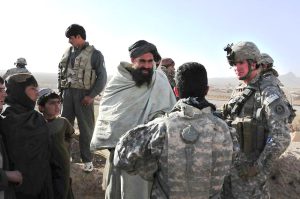
Machine Foreign Language Translation systems are providing Soldiers in the field with a greater ability to communicate with local populaces when linguists are not available.
Obtaining information, providing assistance and forging relationships are very tuff things to do when first meeting people, but it is even tougher when you are in a combat environment and don’t speak the language. That was the scenario many US forces were faced with as they began to work with local citizens in Iraq and Afghanistan trying to provide assistance, gain intelligence and a situational awareness for force protection with few ways to communicate accurately especially with a shortage of qualified linguists.
The initial solution to overcome some of the language barriers was to field a quick reaction capability (QRC) that could meet the immediate need while a more robust program of record (POR) known as the machine foreign language translation system could be developed. The earliest devices that were used to bridge the gap had pre-scripted words and phrases that would include simple phrases such as “get out of the car, what is your brother’s name, do you have a bomb”. A Solider would touch that phrase and it would come out in the other language letting the native speaker now what you wanted them to do.
“Unfortunately there aren’t enough linguists to go around and not all of them can put on a rucksack and go up and down mountains in Afghanistan and follow troops around, so we have to fill that capability gap with these devices,” said Mike Beaulieu, product director Machine Foreign Language Translation Systems (PD MFLTS).
The list of QRCs that were fielded includes the Foreign Media Monitoring System (FMM) which offers a real-time automatic machine translation, search, and alerting capability across multiple media and languages providing rapid insight into emerging events. FMM allows for the correlation of open source
information and development of intelligence products for strategic or tactical use. PD MFLTS also fielded a 2-way Speech to Speech (2WS2S) Translator Laptop System that provides a two-way speech-to-speech machine translation capability as well as the Voice Response Translator (VRT) which provides hands free, eyes free and voice activated one-way phrase based machine translation capability. Additionally the organization fielded the Phraselator P2 which provides Voice and touch activated one-way phrase based machine translation capability.
PD MFLTS’ most recent activities included responding to an urgent operational need request from Theater, for more than 100 two way speech to speech devices that are housed on an Android based Smartphone. In the beginning of 2011, the systems went to two battalions within the 4th Brigade Combat Team of the 101st Airborne Division that are currently deployed to Afghanistan. “Right now the systems are there on an operational assessment and they will be there until the beginning of September. During this deployment we will gather information to improve the product and to inform a decision as to how to do a follow on product because eventually we will have a theater wide product out there,” noted Beaulieu.
PD MFLTS worked with the Defense Advanced Research Projects Agency and TRADOC Capability Manager Biometrics and Forensics to field systems that could meet the 101st’s needs. The unit wanted a two way device that goes both ways and wanted it to be free speech instead of phrased based. Additionally, the organization required a handheld device that would speak two of the main languages in Afghanistan, Pashtu and Dari.
Building off of the success from previous versions of language translation systems and utilizing lessons learned from current efforts such as the Smartphones that were fielded to the 101st, PD MFLTS will refer to all the collected feedback to inform the POR. “The POR device is going to be software but it could be that the software that we provide is an application and it resides on a Smartphone that someone else owns, “said Beaulieu.
MFLTS will be designed to operate in several different configurations to include: a portable configuration (same as handheld), a mobile configuration like a laptop and then there is a net enabled configuration. Ultimately there will be a configuration form factor that would allow people to talk to others one on one in the field.
Eventually MFLTS will offer Soldiers in the field a software capability that can translate any language needed and will be embedded in other major Army programs such as the Distributed Common Ground System-Army (DCGS-A), Prophet Enhanced and the US Army Counterintelligence and Human Intelligence Automated Reporting and Collection System (CHARCS) where it will serve as the translation portion of those intelligence gathering and analysis systems. In addition to having a speech to speech capability the system will also be able to perform text to text as well.
As Beaulieu looks to the future, he reflected on the sheer importance MFLTS can serve. “In the counter insurgency strategy it has been recognized that language and linguistic capabilities are one of the seven key cornerstones for success in the counter insurgency strategy in Afghanistan, so this is pretty important stuff. If you can’t talk to the people that you are trying to win the hearts and minds of, it is kind of hard to win a counter insurgency.”